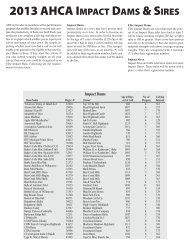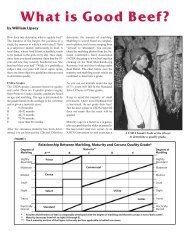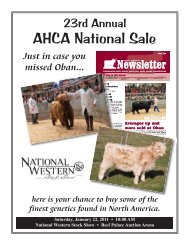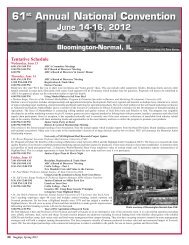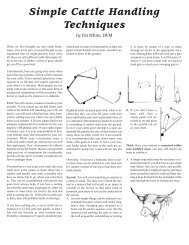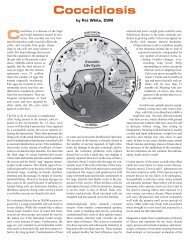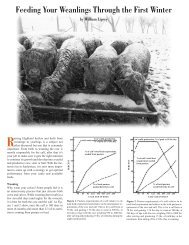The Bagpipe - American Highland Cattle Association
The Bagpipe - American Highland Cattle Association
The Bagpipe - American Highland Cattle Association
You also want an ePaper? Increase the reach of your titles
YUMPU automatically turns print PDFs into web optimized ePapers that Google loves.
GENETICS 101<br />
Scott Barao, Ph.D.<br />
Over the years, I have noticed that breeding time brings with it a number of questions related to genetics and<br />
selection as beef producers buy bulls and/or select semen for use in their cow herd. <strong>The</strong> basis for most of the<br />
questions I get is a general desire to improve herd performance and make positive genetic change. <strong>The</strong> following<br />
information should help clarify the issues related to genetic change and help beef producers set realistic expectations<br />
for their breeding and selection program.<br />
Genetic change is dependent upon four major factors as described in the following formula:<br />
Genetic =<br />
Accuracy<br />
of X Selection X Genetic<br />
Change Selection Intensity Variation<br />
Generation Interval<br />
Accuracy of Selection: Refers to our ability to select animals that truly are genetically superior for a given trait. It<br />
is dependent upon the use of consistent and accurate genetic evaluation techniques.<br />
Selection Intensity: Is dependent upon the proportion of animals kept as parents for the next generation. Intensity<br />
also includes the superiority of those animals compared to the genetic average of the overall unselected population.<br />
Refers to the relative differences among animals that are controlled by genetic factors. It is measured as the heritability<br />
of the trait.<br />
Genetic Variation: A common phenomenon, manifesting itself as dominant and recessive genetic traits.<br />
Generation Interval: Is the average age of a parent when the offspring is born.<br />
To achieve rapid genetic change, accuracy of selection must be high and parents must be genetically superior when<br />
compared to the average population. In addition, more progress will be achieved with more highly heritable traits and<br />
shorter generation intervals. By keeping these four factors in mind, genetic progress can be maximized.<br />
Genetic Terms<br />
In addition to understanding the components of “Genetic Change,” producers must also have a working knowledge<br />
of some important genetic terms.<br />
Cell - All animals are made up of thousands of cells. Genetic material is located in the nucleus of each body cell.<br />
Chromosomes are the structures within the nucleus that contain the genes. Genes are hereditary units that determine<br />
a portion of the animal’s appearance, performance, behavior and other characteristics.<br />
Chromosome - In beef cattle, 30 pairs of chromosomes are located in each cell’s nucleus. <strong>The</strong> number of chromosomes<br />
varies among animals. Humans have 23 pairs of chromosomes.<br />
Genes - Genes are hereditary units that influence the expression of specific traits.<br />
Allele - An allele is one component of the gene pair which is located at a given locus or position on the chromosome.<br />
Locus - <strong>The</strong> locus is the region of the chromosome where a particular gene is located.<br />
DNA - Chromosomes are chemically composed of DNA (deoxyribonucleic acid). DNA is a nucleic acid arranged in a<br />
double helical structure.<br />
13



